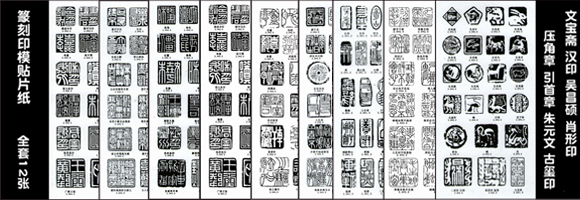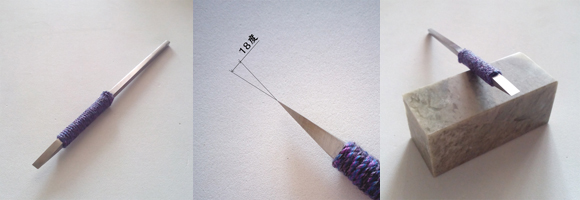清初印家大多是明末遗民。流风笼罩加上师承及地域因素,使一些篆刻家多以摹习文彭、 何震等人的印法相标榜,并视之为艺术的典范。同时新的风格因素也开始出现,在渐变中完成向文人篆刻全盛时期的过渡。
清初篆刻——因循与流变
Seal Engraving in the Early Qing — Following the Old Ways and Seeking for Changes
清初印家大多是明末遗民。流风笼罩加上师承及地域因素,使一些篆刻家多以摹习文彭、 何震等人的印法相标榜,并视之为艺术的典范。同时新的风格因素也开始出现,在渐变中完成向文人篆刻全盛时期的过渡。
清初吴门印人顾听、 顾苓传文彭雅正的家法,代表了清初印风的一脉。
Most early Qing seal engravers were survivors from the late Ming years. A combination of lingering customs, regional factors and the training they had received meant that some seal engravers vaunted themselves as reproducing the style of Wen Peng and He Zhen, seeing themselves as role models. At the same time, some new elements of engraving style appeared ; in the course of the gradual change, scholar seal engraving completed its transition to its fullest flowering.
In the early Qing years, Gu Ting and Gu Ling of Wumen (today’s Suzhou)carried on Wen Peng’s family technique representing one early Qing style school.

清,顾听刻“卜远私印”,紫砂,上海博物馆藏
Purple sand seal “Private Seal of Bu Yuan”(卜远私印), engraved by Gu Ting. Qing Dynasty. Shanghai Museum
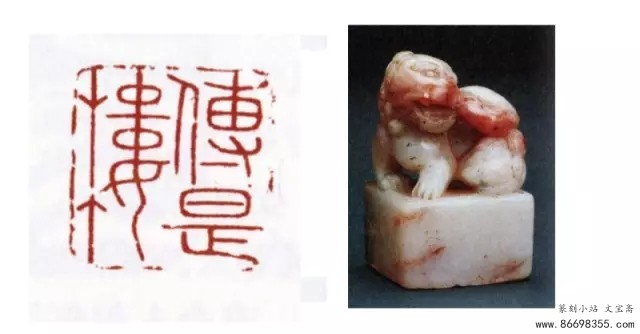
清,顾芩刻“传是楼”,寿山石,上海博物馆藏
Shoushan stone seal “Chuan Shi Pavilion (传是楼), engraved by Gu Ling. Qing Dynasty. Shanghai Museum
清初篆刻家对古印的艺术特征,认识较早期更为深刻 。
与顾听同时的松江籍印家葛潜,亦为仿汉印的高手。葛潜字振千,号南庐,活动于康熙、乾隆年间。治印刀法稳实丰厚,布局以简洁大方为基调 。传世作品有瓷印“米汉雯印”。
The seal engraving maters of the early Qing years had a deeper knowledge of the artistic qualities of ancient seals than earlier practitioners.
Ge Qian, styled Zhenqian, a masters seal engraver of Songjiang County, lived around the same time as Gu Ting and was also an adept imitator of the Han Dynasty style. Hallmarks of Ge Qian’s work are his robust , rich cutting and his simple, expansive composition. Among his extant work is a porcelain seal inscribed “Seal of Mi Hanwen” (米汉雯印).
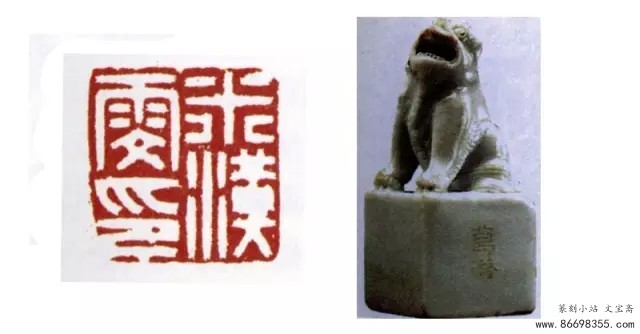
清,葛潜刻“米汉雯印”,瓷,上海博物馆藏
Porcelain “Seal of Mi Hanwen”(米汉雯印),engraved by Ge Qian. Qing Dynasty. Shanghai Museum
文彭、何震、苏宣印风的影响,在清中期以后渐趋淡远。
汪关所创印风,至清初赏音不绝。汪氏父子为学山堂张灏所刻印章流散后,大部分传入虞山,纯正古雅的格调为世人所接纳。
侨居虞山的福州青田人林皋步武汪氏,在清初影响很大。林皋(1657~1712年后),字鹤田,刻印工细精密,将汪关的妍美工致风格推向极致,为后世细朱文印式及雅正的仿汉印风格拓开新境。
From the middle of the Qing Dynasty, the stylistic influence of Wen Peng, He Zhen and Su Xuan gradually waned.
The style initiated by Wang Guan was appreciated till the early Qing. After the seals cut by Wang Guan and his son for Zhang Hao’s Xueshan Chamber were scattered, most of them went to Yushan in Jiangsu. Their style of purity and ancient elegance was accepted by the people.
Lin Gao(1657-c.1712), a follower of Wang Guan, was extremely influential in the early Qing. Styled Hetian, he was born in Putian near Fuzhou, Fujian Province, but lived in Yushan, Jiangsu. He cut seals with careful and meticulous craftsmanship, and brought to perfection Wang’s style of elegance and neatness, thus opening a new realm for characters with fine strokes cut in relief and the imitation of Han Dynasty style.
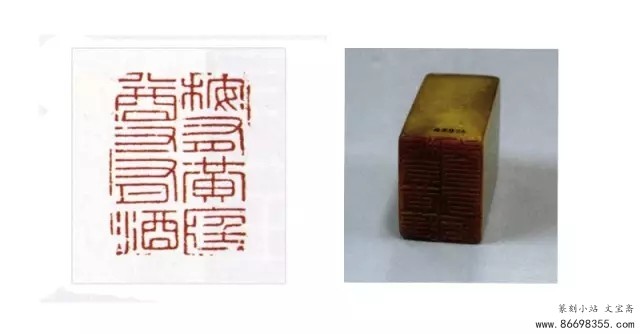
清,林皋刻“案有皇庭尊有酒”,青田石,上海博物馆藏
Qingtian stone seal “On the table, the Huangting Scripture, in the vessel, wine”(案有皇庭尊有酒), engraved by Lin Gao.Qing Dynasty. Shanghai Museum
明清之际不同地域的印风差异扩大。
许容(1635~1693年后),字实夫,号默公,江苏如皋人。刻印讲求布局奇巧。 稍后的童昌龄和嘉庆、 道光年间的黄学屺刻印亦宗其法,后人视为“如皋派”。
程邃(1605~1691),字穆倩。清初徽州篆刻家多因袭何震、苏宣印风,歙县程邃不为时尚左右,渐创新体,被尊为歙派的宗师。
Regional differences in seal styles became more pronounced in the late Ming and the early Qing.
Xu Rong(1649-c.1693), styled Shifu, Was born in Rugao, Jiangsu. He paid more attention to ingenious layout. Tong Changling, who was a bit later, and Huang Xueqi in the first half of the 19th century, took his technique and style as their model. They are regarded as the “Rugao school.”
Cheng Sui(1607-1692), styled Muqian. The majority of early Qing seal en-gravers in Huizhou followed the styles of He Zhen and Su Xuan. By contrast, Cheng Sui in She County did not go along with the crowd but gradually created a new style of his own, and was honored as the “Grand Master of She County.”
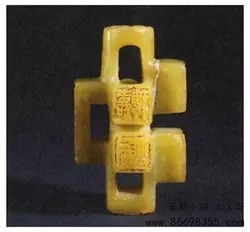
清,徐容刻“冒嘉穗私印”六面印,青田石,上海博物馆藏
Six-Faced Qingtian stone “Private Seal of Mao Jiasui”(冒嘉穗私印), engraved by Xu Rong. Qing Dynasty. Shanghai Museum
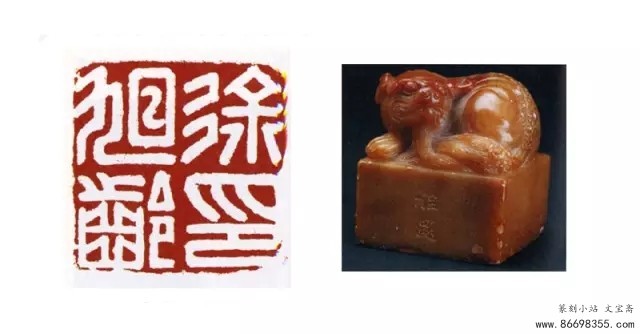
清,程邃刻“徐旭龄印”,寿山石,44×44mm,上海博物馆藏
Shoushan stone seal “Seal of Xu Xuling”(徐旭龄印),engraved by Chen Sui. Qing Dynasty. Shanghai Museum
清初以后,篆刻作品边款的文字内容与形式较明代有长足的扩展,出现了铭刻长篇记事文字或诗文的作品,印款的赏读价值受到重视 。刻款刀法的个性化和个人书法风格的介入也更为鲜明 。这些都对其后的篆刻创作具有积极的影响。
From the early Qing, the content and form of side inscriptions made huge strides by comparison with pieces from the Ming. Works appeared with long narratives or poems during this period, and the esthetics and content of the side inscriptions were highly valued. In engraving technique and in calligraphy alike individuality became increasingly distinct. This combination of factors had a very beneficial impact on later creative work.
加微信获取:wenbaozhai365
